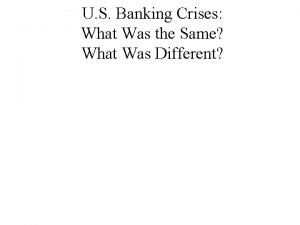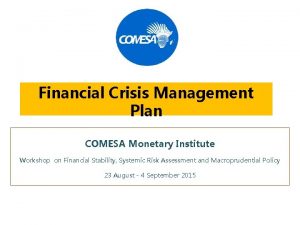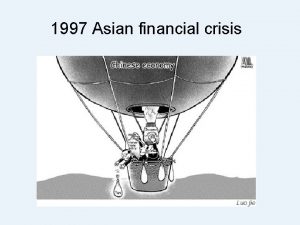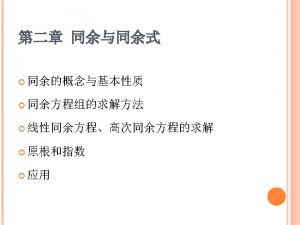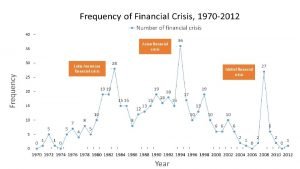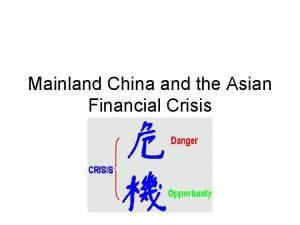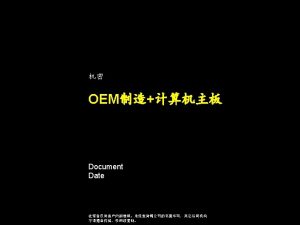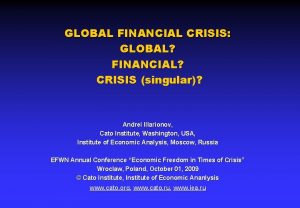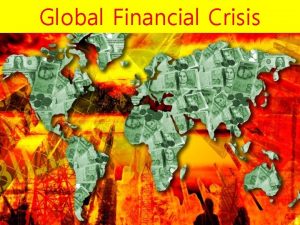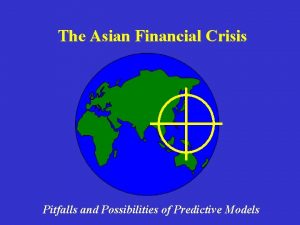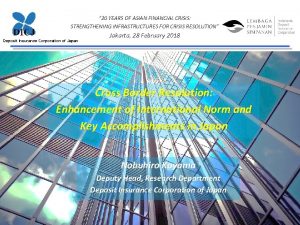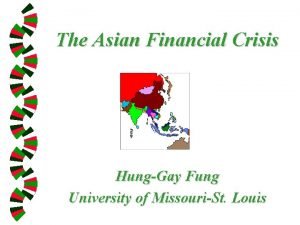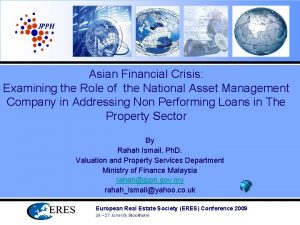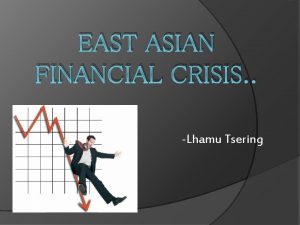THE ASIAN FINANCIAL CRISIS 1997 ASIAN FINANCIAL CRISIS




















- Slides: 20

THE ASIAN FINANCIAL CRISIS

1997 ASIAN FINANCIAL CRISIS • The Asian financial crisis was a period of financial crisis that gripped much of East Asia beginning in July 1997 and raised fears of a worldwide economic meltdown due to financial contagion.

1997 ASIAN FINANCIAL CRISIS • Foreign debt-to-GDP ratios rose from 100% to 167% in the four large Association of Southeast Asian Nations economies in 1993– 96, then shot up beyond 180% during the worst of the crisis. In South Korea, the ratios rose from 13% to 21% and then as high as 40%, while the other northern newly industrialized countries fared much better. Only in Thailand South Korea did debt service-to-exports ratios rise.

• Although most of the governments of Asia had seemingly sound fiscal policies, the International Monetary Fund (IMF) stepped in to initiate a $40 billion program to stabilize the currencies of South Korea, Thailand, and Indonesia, economies particularly hard hit by the crisis. The efforts to stem a global economic crisis did little to stabilize the domestic situation in Indonesia, however. After 30 years in power, President Suharto was forced to step down on 21 May 1998 in the wake of widespread rioting that followed sharp price increases caused by a drastic devaluation of the rupiah.

1997 ASIAN FINANCIAL CRISIS • The crisis started in Thailand with the financial collapse of the Thai baht after the Thai government was forced to float the baht due to lack of foreign currency to support its currency peg to the U. S. dollar. At the time, Thailand had acquired a burden of foreign debt that made the country effectively bankrupt even before the collapse of its currency. As the crisis spread, most of Southeast Asia and Japan saw slumping currencies, devalued stock markets and other asset prices, and a precipitous rise in private debt.

1997 ASIAN FINANCIAL CRISIS Country GNP (US $1 billion) Change June 1997 July 1998 Thailand 170 102 -40. 0% Indonesia 205 34 -83. 4% Philippines 75 47 -37. 3% Malaysia 90 55 -38. 9% South Korea 430 283 -34. 2%

1997 ASIAN FINANCIAL CRISIS • The effects of the crisis lingered through 1998. In 1998 the Philippines growth dropped to virtually zero. Only Singapore and Taiwan proved relatively insulated from the shock, but both suffered serious hits in passing, the former more so due to its size and geographical location between Malaysia and Indonesia. By 1999, however, analysts saw signs that the economies of Asia were beginning to recover. After the 1997 Asian Financial Crisis, economies in the region are working toward financial stability on financial supervision.

TIME LINE OF THE CRISIS:PART I • July 2, 1997, Thailand announced to abandon the fixed exchange rate system, the implementation of floating exchange rate system, triggering a financial crisis throughout Southeast Asia. On the same day, the exchange rate of the Thai baht was reduced by 17%, and foreign exchange and other financial markets were in chaos. In August 1997, Malaysia abandoned the efforts to defend the ringgit. The already strong Singapore dollar has also been hit. Although Indonesia is the "infected" the latest country, but by the impact of the most serious.

PART II • In late October 1997, the Taiwan authorities suddenly abandoned the NT exchange rate, depreciating 3. 46% a day. October 23, 1997, the Hong Kong Hang Seng Index fell 1211. 47 points; 28, down 1 621. 80 points, fell below 9 000 points. • In mid-November 1997, South Korea also broke the financial turmoil in South Korea, 17, the Korean won against the dollar fell to a record of 1008: 1. 21, the South Korean government had to seek help from the International Monetary Fund, temporarily control the crisis. But on December 13, the Korean won against the dollar fell to 1737. 60: 1. The crisis also hit the Japanese financial industry, which had invested heavily in Korea.

PART III • In the second half of 1997, a series of banks and securities companies in Japan went bankrupt. Southeast Asian financial turmoil evolved into the Asian financial crisis. • At the beginning of 1998, the Indonesian financial turmoil began to face the most serious economic recession ever, the International Monetary Fund for Indonesia to develop countermeasures failed to achieve the desired results.

PART IV • February 11, 1998, the Indonesian government announced the implementation of the Indonesian rupiah and the dollar to maintain a fixed exchange rate linked to the exchange rate system to stabilize the Indonesian rupiah. The move was unanimously opposed by the International Monetary Fund and the United States and Western Europe. The International Monetary Fund threatened to withdraw its aid to Indonesia is in a crisis of political economy. • February 16, 1998, the Indonesian rupiah with the dollar fell below 10 000: 1. Affected by the resurgence of Southeast Asian currency, Singapore dollar, RM, Thai baht, Philippine peso, etc. have fallen. Until 8 April Indonesia and the International Monetary Fund on a new economic reform program to reach an agreement, the Southeast Asian foreign exchange market was calm.

PART V • The outbreak of the financial crisis in Southeast Asia in 1997 made the Japanese economy inextricably linked to it. The yen exchange rate from the end of June 1997 115 yen against 1 US dollar fell to early April 1998 133 yen against 1 US dollars; 5, 6 month, the yen exchange rate all the way down, once close to 150 yen against 1 US dollars pass. With the sharp depreciation of the yen, the international financial situation is more uncertain, the Asian financial crisis continues to deepen. • The Russian central bank announced on Aug. 17 that it would extend its rupiah exchange rate to 6. 0 to 9. 5: 1 during the year and postpone repayment of foreign debt and suspension of bond trading.

PART VI • September 2, 1998, the ruble depreciation of 70%. This makes the Russian stock market, foreign exchange market fell sharply, triggering financial crisis and even economic, political crisis. Russia's policy changes, led the US and European stock markets of the currency market volatility. By the end of 1998, the Russian economy was still out of the woods. In 1999, the financial crisis ended.

• The cause of the outbreak The Southeast country and South Korea and other countries are export-oriented economy countries, their dependence on the world market is very large. Asian economic turmoil will inevitably lead to move the whole body of the situation. In Thailand, for example, the baht in the international market whether to buy and sell is not the Thailand government can control , and Thailand itself does not have enough foreign exchange reserves, when face of financial speculation, the country's economy is vulnerable.

ANOTHER IMPORTANT REASON : THE MOST HATED BY SOUTHEAST ASIAN LEADERS

GEORGE SOROS ---- SNIPER THE BAHT • Assuming at the beginning the exchange rate is 1: 25, Soros borrowed from Thailand's bank a large number of baht, and then sell to the foreign exchange market to buy U. S dollars, because Soros is a large number of sellers in batches so it is easy to cause foreign exchange market panic, So that everyone thinks that the baht has the risk of a collapse problem, through this flock effect to enlarge the sale of the baht, the baht exchange rate fell. Assuming that make exchange rate fall to 1: 50, then Soros can use a small amount of dollars to buy back the baht, the middle of the difference is the proceeds. At the same time Soros can be a long-term market with people on the bet, betting baht will be a significant depreciation (because he will be empty baht to devalue), in this market Soros can make a big profit.

THESE COUNTRIES HAVE ELIMINATED A LOT OF POVERTY AND IT IS PART OF THE "ASIAN MIRACLE", BUT FACED WITH A SEVERE RECESSION.

• First, when managers face new financial opportunities after financial liberalization, managers of financial institutions lack effective risk management experience. Moreover, with the rapid increase in credit, financial institutions can not quickly increase the necessary management system (such as well-trained loaners, risk estimation systems, etc. ) to effectively monitor these new loans. The second reason is the imperfect regulation / regulatory system. Depositors and foreign lenders who lend to Bank of East Asia know that the government is likely to come forward to protect them, so there is no incentive to supervise the bank, which has led them to take too much risk and take the initiative to find new lending opportunities.

• The above-mentioned asymmetric information analysis of the East Asian financial crisis and the causes of economic recession can be used to sum up several lessons to prevent such crises from happening again and what to do when a crisis occurs. The first lesson from the crisis is that the financial system should be stabilized through reasonable government intervention; for emerging market countries, this requires international lenders. The second lesson is that the international final lender must develop appropriate loan conditions to avoid the formation of excessive hazard that creates financial instability. The third lesson is that while capital flows are related to crises, it is only a phenomenon, not a source of crisis: foreign exchange controls are unlikely to work to prevent future crises. The fourth lesson is that the fixed exchange rate system is very dangerous for emerging market countries, making financial crises more prone.

 Asian financial crisis
Asian financial crisis Myasthenic crisis vs cholinergic crisis
Myasthenic crisis vs cholinergic crisis Comesa monetary institute
Comesa monetary institute Showa financial crisis
Showa financial crisis ưu thế lai là gì
ưu thế lai là gì Kể tên các môn thể thao
Kể tên các môn thể thao Tư thế ngồi viết
Tư thế ngồi viết Cái miệng xinh xinh thế chỉ nói điều hay thôi
Cái miệng xinh xinh thế chỉ nói điều hay thôi Hát kết hợp bộ gõ cơ thể
Hát kết hợp bộ gõ cơ thể Mật thư anh em như thể tay chân
Mật thư anh em như thể tay chân Từ ngữ thể hiện lòng nhân hậu
Từ ngữ thể hiện lòng nhân hậu Tư thế ngồi viết
Tư thế ngồi viết Thứ tự các dấu thăng giáng ở hóa biểu
Thứ tự các dấu thăng giáng ở hóa biểu Chó sói
Chó sói Thẻ vin
Thẻ vin Thể thơ truyền thống
Thể thơ truyền thống Hổ sinh sản vào mùa nào
Hổ sinh sản vào mùa nào Thế nào là hệ số cao nhất
Thế nào là hệ số cao nhất Diễn thế sinh thái là
Diễn thế sinh thái là Vẽ hình chiếu vuông góc của vật thể sau
Vẽ hình chiếu vuông góc của vật thể sau
